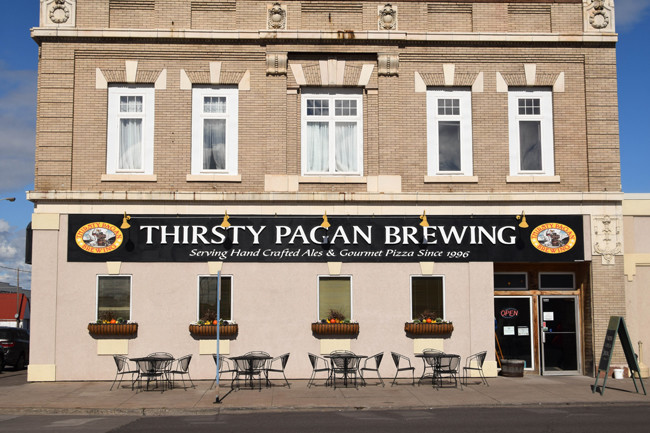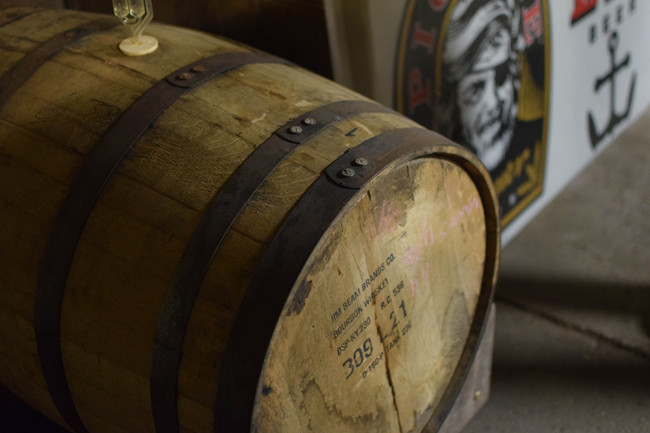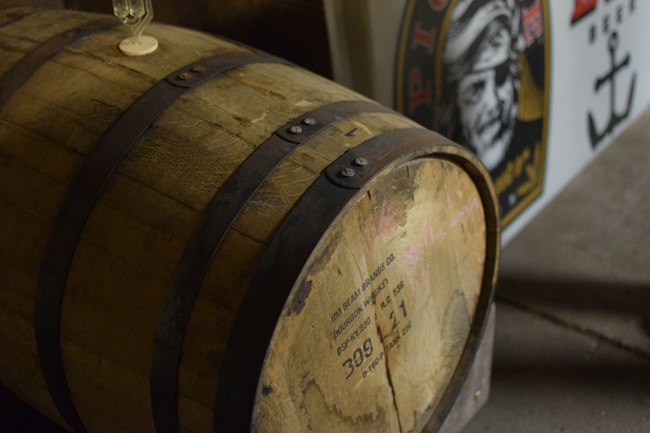
Allyson Rolph, the head brewer at Superior, Wisconsin’s Thirsty Pagan brew pub and pizzeria, has been working there for a little more than three years. After starting as a festival volunteer, pouring beer for zealous tasters, and then transitioning to an intern role, she took over as head brewer eight months in. Now she’s experimenting with sour beers while expanding the brewery’s operations, keeping a strong focus on quality and a keen eye on the restaurant’s core consumers. These may or may not be beer geeks, but the beer Rolph makes can be respected by beer aficionado and newbie alike. We sat down with her for a chat over some of the brewpub’s famous pizza — and went on a tour — while discussing how she got to where she is today and where she sees herself and the brewpub going in the future.
HEAVY TABLE: What were you doing before you started brewing for the Thirsty Pagan?
ALLYSON ROLPH: My degree is in art, I have a B.A. in fine arts from [Minnesota State University,] Mankato. I was working and managing a frame shop in an art gallery in Duluth. The paintings in here are my assistant brewer Jaredt’s. He has an art degree too. When people talk about brewing as a really creative thing — well, it is, but it’s also a science, and it’s a lot of cleaning and a lot of small, detailed work.
But then there’s the creative part, where you’re looking around the world around you and saying, “What flavors do I want to see in the beer?” You’re bringing in that artist’s perspective, and what I think of as the artist’s perspective is being able to really perceive your world — really being able to look and see and bring those things that you’re noticing as details in the life around us and bringing that in as art, whether it’s paintings, or if it’s things you find really interesting in food, like curry: How can some of those curry flavors come into a beer?

HEAVY TABLE: Tell me about the beers that are in the lineup right now.
ROLPH: Up on the board right now we have — on the left side are our house beers. These are the beers that we always have on tap: Northwest Amber, Derailed Ale, Burnt Wood Black are all original beers from when this place was called Twin Ports Brewing. Nate [McAlpine], the brewer before me, added the IPA, the India Pagan Ale, because at the time when he added it, it was like, “How can you not have an IPA?” Those are the four beers that I was required to make.
The first seasonal I brewed as the head brewer here was the Lawn Chair. It’s a cream ale, so it’s an ale version of a light American lager, essentially because this is a restaurant, and you do have to keep in mind we have a lot of people who come in and ask for the Bud, the Miller, the Coors, the big domestic light lager, and we don’t have that. So making a light, clean, crisp, approachable beer that might not have too much “flavor” is necessary. They may have brand loyalty, but they still want a beer with their pizza.
I enjoy Belgian styles, so Velo Saison and the Trouble Maker Tripel are Belgian-inspired beers. Both of these are made with a yeast that we collected in the Duluth hillside last year.
One of my neighbors has fruit trees in his backyard, and when we went to pick plums, there was a ton of them on the ground, and you could smell the fermentation; it was super sweet, floral, and estery — kind of fruity. Once you’re in a brewery you know what that smell is.

So I collected a few of the plums in a bag, and I came here, and the next time I brewed, I cut the fruit up and put [it] in a growler, and it started to ferment. It fermented out on our Pale Ale wort as quickly and to the same final gravity as American ale yeast, which is a house yeast. So we knew it had some good stuff in there. We separated out a single yeast colony and built that back up and did some experiments on it; it became what we use for our saison and our Tripel and also some of our seasonal Belgian-inspired beers.
When it comes to the seasonals, right now we have a saison, a blonde and a Pils. We have a 7-barrel brewery but we also had a 2-barrel brewery that we still operate. Sometimes we like to use our fermenters to split a batch, so the saison, the blonde and the Pils are all the same wort, just split into three fermenters. It’s a really traditional wort, what I would think of as a pretty basic Pilsner recipe, split into those three fermenters, and fermented by three different yeasts to showcase the difference in what yeast can do in a beer and the difference it makes in a final product.

HEAVY TABLE: Do you think your customers see and appreciate that kind of experimentation?
ROLPH: It’s still a restaurant, and I always remember that. Not everyone who comes here is here for the beer. We’re well known for our pizza, and we have music seven nights a week, so we have a lot of people who come in here who aren’t just big beer drinkers. If you can’t find something on this beer board that you like, then I don’t know what kind of beer you want.
And then we have wild, sours, and Brett beers, which is kind of [our] passion project. Three years ago, when people were asking what’s the next big thing, I was saying sour beers. Kettle sours, mixed fermentation — it’s really exciting to see all of these things that I’ve been pitching coming to the forefront in the general population, not just with the people who are super into beers.
Almost all of our sour beers are named after dogs. Reinhold is a Saint Bernard that is owned by one of our former kitchen managers. Monet, the sour that is on right now, is named after my dog, my Siberian Husky. The third one, we didn’t name our kettle red after any dogs, instead we did a lot of experiments with it; we fermented part of it with a local yeast, part of it in a fermenter; some of it went downstairs, and we put it into a bourbon barrel that we had aged a barleywine in. It picked up a lot of those really amazing barrel aged barleywine flavors like caramel, and we did a few firkins with it. It’s a sour that’s different from the pack.
HEAVY TABLE: Tell me about the new beer garden.
ROLPH: We have a new beer garden and patio out back, probably to [owner] Steve [Knauss’s] regret. He told me just to make a beer fridge to serve beer out there, so I made a beer fridge that I would have in my house. It has four firkins that run on a hand pump, and there are six taps. We can run wine back there, but it also has nitro, and CO2 at many different pressures. It’s basically a beer geek’s keg fridge. I want to be able to serve anything, whether it’s kombucha or coffee on nitro.

HEAVY TABLE: What do you think the path for the brewery is?
ROLPH: Here, I’ve actually kind of maxed out my hours. I have to keep adding people in the brewery. I want to able to add more quality assurance and quality control aspects to our beer, and to free up more time to do that is great — also, being able to add more to the sour, wild, and Brett program. In the last two years, we added a bourbon barrel program, and I see those growths continuing. Will we ever bottle, can, or distribute? Who knows? That is not a priority for us, since we still are able to sell everything we make across the bar.
We’re finally at a point where we are able to make purchases when we need to. A lot of the times when we make these growth steps, we’re able to save up. We can say, “Here’s our bottleneck, and OK, we need to grow here, so put some savings into here.” And in a short amount of time, we’ll be able to take those steps.
It’s fortunate that we’ve been successful enough that Steve is able to put money where he needs to, when he needs to, where some breweries are like, “We don’t have the funding to do it.” Not a lot of places have an expansive basement they can move into like we can, elbow things around, and say, “This is my space now.” I’ve definitely peed all over this place — this room is mine; this room is mine.

HEAVY TABLE: What fears do you have about brewing and the brewery’s growth?
ROLPH: I think as a brewer — the same thing I saw as being an artist — you can create as much art as you want, but when you put it out there on display for someone to see is when you become an artist. That’s always really hard because it’s about presentation. I like to be in the taproom because I get to be the person that hands this beer across the bar to somebody. When you’re a home brewer it’s like, “Hey, try my beer,” and they’re like, “Hey, it’s great! It’s free!” But when you’re expecting someone to give you money in response to this product you’ve made, you want it to be that thing that they expect and like.

HEAVY TABLE: Where do you see yourself going as a brewer?
ROLPH: Right now I’ve been really fortunate to be supported by my ownership to pay for brewing school, so I’m doing the Siebel Institute online. Rather than doing a module where I go to Chicago for two weeks, and that’s all I do for hours and hours a day, I do school at night. We — as a brewery — we try to take advantage of as many educational opportunities as possible to grow and learn and bring more tools to the tool box.
HEAVY TABLE: To what extent has being a female brewer in a male-dominated industry impacted what you do?
ROLPH: It’s a question I always get. To be quite honest with you, there has not been a single thing in the brewery that I have not been able to do — like, “Oh, I cannot do this without a man.” If there’s something in the job that I can’t lift, then Jaredt shouldn’t be lifting it either. This should be a team lift or we shouldn’t be doing it at all. But at the same time, I’m appreciative of the attention because the more women out there who see women in the brewing industry, the more likely they are to be like, “Oh, I never really thought of this as a career. Why not?”
If it brings more people in, then I’ll definitely play to that, and be like, “Well, yes, you too, young girl, can be a brewer! You too can spray stuff with a hose and scrub things and make really good, clean beer! Yes! Do it!” But I also like to make a joke about it because I think it’s sometimes really silly, especially the question of “What is the hardest thing about being a female in the brewing industry?” My response is, ‘‘Well, I can’t grow a beard.”
I have extremely high expectations of myself and expectations of the guys that work with me because I do feel that extra pressure. I have to make extremely good beer because if I fail, they’re going to say it’s because I’m a woman. People can’t say anything negative about me if I make good beer. It’s not about me being the new brewer or a female brewer or this or that; it’s like, “Well, do I make good beer?” Then that’s all I care about. I would say that I have expectations of myself that are higher than everybody else has for me.



Comments are closed.